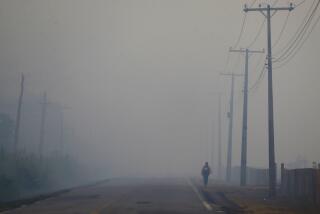High Hopes Riding on New Congo Road
- Share via
IMPFONDO, Congo — A thin asphalt ribbon cuts through dense jungle and swamp linking three thriving towns on Congo’s Ubangui River before disappearing into the northern tropical rain forest.
Congo is proud of the $145-million two-lane road connecting Epena, Impfondo and Dongou, but the only way to reach the area is by river or air.
The road is seen as important to the development of the neglected northern interior and as a potential link in the longstanding but elusive plan for a trans-African highway between Kenya and Nigeria.
But the 85-mile road connects with no other; the nearest point on Congo’s main north-south highway is 250 miles away and the capital--Brazzaville--is 500 miles to the south.
The International Monetary Fund tried to block the project and refused to approve loans for the road, which it said should not be constructed.
Congo turned elsewhere and obtained loans from a Brazilian consortium sponsored by Banco do Brasil.
A Brazilian construction company with road-building experience in the Amazon--Andrade Gutierrez--got the contract.
“For us, this road has a political purpose, which is to link people and promote national unity,” President Denis Sassou-Nguesso said at the inauguration ceremony in August. The road is named after him.
“It is essential for those who were forced previously to walk for weeks on end through hostile jungle.”
Most people will still have to walk, since there are no buses and the only cars are those belonging to the construction company or local officials.
But residents believe the road will help end their isolation. Local chieftains, as a token of appreciation, offered Sassou-Nguesso an 18-year-old woman as a wife, an honor that the already-married president declined.
It took 1,200 workers, including local tribesmen and 400 Brazilians, four years to build the road--most of the time spent on one 16-mile stretch through swamp.
“We had to resort to a special technique for the (16 miles) through the swamp,” company engineer Marco Mirando Diogo said. “We went about (70 to 130 feet) a day.
More to Read
Sign up for Essential California
The most important California stories and recommendations in your inbox every morning.
You may occasionally receive promotional content from the Los Angeles Times.













